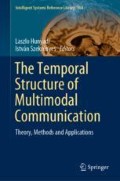Abstract
The topic of this chapter is a particular state of mind: uncertainty. One can experience uncertainty in many contexts and situations: in relation to events past, present and future, persons close and far, tasks, choices, measures, decisions desired or to be avoided, and much more. It is very personal, and therefore it has hardly innumerable forms of expression. Due to its personal nature, one may find it difficult to observe it by trying to associate it with just one or another single behavior, especially that it most often develops as a sequence of behavioral events over time. Based on the HuComTech multimodal corpus and using the computing environment Theme we show a complex of those individual events that, together, contribute to the perception of uncertainty. This complex is essentially temporal, in which patterns of behavior are formed from temporally adjacent or non-adjacent events including physically observable ones as well as those which are only interpretations of certain observations. The data are based on dialogues in Hungarian, but their multimodal analysis can be applied to other language environments as well.
I dedicate this work to Aron, who will always be 27.
This chapter was supported by Grant NKFIH 116402
Access this chapter
Tax calculation will be finalised at checkout
Purchases are for personal use only
References
Bach K, Harnish R (1979) Linguistic communication and speech acts. MIT Press, Cambridge, Mass
Bunt H, Alexandersson J, Carletta J, Choe J, Fang AC, Hasida K, Lee K, Petukhova V, Popescu-Belis A, Romary L, Soria C, Traum D (2010) Towards an ISO standard for dialogue act annotation. In: Proceedings of the seventh conference on international language resources and evaluation (LREC10, Valletta)
Hunyadi L (2011) A multimodális ember-gép kommunikáció technológiái – elméleti modellezés és alkalmazás a beszédfeldolgozásban [technologies of multimodal human-machine communication—theoretical modeling and application in speech processing]. In: Enikő Németh T (ed) Ember-gép kapcsolat. A multimodális ember-gép kommunikáció modellezésének alapjai [The relationship between human and machine. The bases of the modelling of multimodal communication between human and machine]. Tinta Könyvkiadó, Budapest, pp 15–41
Hunyadi L, Földesi A, Szekrényes I, Staudt A, Kiss H, Abuczki A, Bódog A (2012) Az ember-gép kommunikáció elméleti-technológiai modellje és nyelvtechnológiai vonatkozásai. [a theoretical-technological model of human-machine communication and its reference to language technology]. In: Kenesei I, Prószéky G, Váradi T (eds) Általános Nyelvészeti Tanulmányok XXIV. Akadémiai, Budapest
Magnusson M (2000) Discovering hidden time patterns in behavior: T-patterns and their detection. Behav Res Methods Instrum Comput 32(1):93–110
Magnusson MS, Burgoon J, Casarrubea M (eds) (2016) Discovering hidden temporal patterns in behavior and interaction: T-pattern detection and analysis with THEME. Springer, New York
Németh TE (ed) (2011) Ember-gép kapcsolat. A multimodális ember-gép kommunikáció modellezésének alapjai [The relationship between human and machine. The bases of the modelling of multimodal communication between human and machine]. Tinta Könyvkiadó, Budapest
Pápay K, Szeghalmy S, Szekrényes I (2011) Hucomtech multimodal corpus annotation. Argumentum 7:330–347
Sperber D, Wilson D (1986) Relevance: communication and cognition. Blackwell, Oxford
Tversky A, Kahneman D (1973) Judgement under uncertainty: heuristics and biases. ONR technical report. National technical information service
Wilson D, Sperber D (2002) Relevance theory. In: Horn LR, Ward G (eds) The handbook of pragmatics. Blackwell, Oxford, pp 607–632
Wilson D, Sperber D (2012) Meaning and relevance. Cambridge University Press, Cambridge
Zipf GK (1935) The psychobiology of language. Houghton-Mifflin, New York
Zipf GK (1949) Human behavior and the principle of least effort. Addison-Wesley, Reading MA (USA)
Author information
Authors and Affiliations
Corresponding author
Editor information
Editors and Affiliations
Rights and permissions
Copyright information
© 2020 Springer Nature Switzerland AG
About this chapter
Cite this chapter
Hunyadi, L. (2020). Uncertainty in Conversation: Its Formal Cues Across Modalities and Time. In: Hunyadi, L., Szekrényes, I. (eds) The Temporal Structure of Multimodal Communication. Intelligent Systems Reference Library, vol 164. Springer, Cham. https://doi.org/10.1007/978-3-030-22895-8_6
Download citation
DOI: https://doi.org/10.1007/978-3-030-22895-8_6
Published:
Publisher Name: Springer, Cham
Print ISBN: 978-3-030-22894-1
Online ISBN: 978-3-030-22895-8
eBook Packages: Intelligent Technologies and RoboticsIntelligent Technologies and Robotics (R0)

